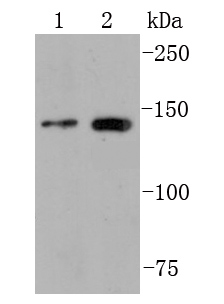Product Detail
Product NameFGFR2 Rabbit mAb
Clone No.JM10-60
Host SpeciesRecombinant Rabbit
Clonality Monoclonal
PurificationProA affinity purified
ApplicationsWB, IP
Species ReactivityHu, Ms, Rt
Immunogen Descrecombinant protein
ConjugateUnconjugated
Other Namesbacteria-expressed kinase antibody
BBDS antibody
BEK antibody
BEK fibroblast growth factor receptor antibody
BFR1 antibody
CD332 antibody
CD332 antigen antibody
CEK3 antibody
CFD1 antibody
Craniofacial dysostosis 1 antibody
ECT1 antibody
FGF receptor antibody
FGFR 2 antibody
FGFR-2 antibody
Fgfr2 antibody
FGFR2_HUMAN antibody
Fibroblast growth factor receptor 2 antibody
Hydroxyaryl protein kinase antibody
Jackson Weiss syndrome antibody
JWS antibody
K SAM antibody
K-sam antibody
Keratinocyte growth factor receptor 2 antibody
Keratinocyte growth factor receptor antibody
KGFR antibody
KSAM antibody
protein tyrosine kinase, receptor like 14 antibody
soluble FGFR4 variant 4 antibody
TK14 antibody
TK25 antibody
Accession NoSwiss-Prot#:P21802
Uniprot
P21802
Gene ID
2263;
Calculated MW145 kDa
Formulation1*TBS (pH7.4), 1%BSA, 40%Glycerol. Preservative: 0.05% Sodium Azide.
StorageStore at -20˚C
Application Details
WB: 1:1,000-1:2,000
IP: 1:10-1:50
Western blot analysis of FGFR2 on different cell lysates using anti-PGFR2 antibody at 1/1,000 dilution. Positive control: Lane 1:MCF-7 Lane 2: Jurkat
Acidic and basic fibroblast growth factors (FGFs) are members of a family of multifunctional polypeptide growth factors that stimulate proliferation of cells of mesenchymal, epithelial and neuroectodermal origin. Like other growth factors, FGFs act by binding and activating specific cell surface receptors. These include the Flg receptor or FGFR-1, the Bek receptor (or FGFR-2), FGFR-3, FGFR-4, FGFR-5 and FGFR-6. These receptors usually contain an extracellular ligand-binding region containing three immunoglobulin-like domains, a transmembrane domain and a cytoplasmic tyrosine kinase domain. The gene encoding human Bek (also designated K-sam) maps to chromosome 10q26.13 and is alternatively spliced to produce several isoforms. Heterogeneous mutations in Bek are associated with a range of craniosynostosis syndromes including Pfeiffer syndrome, Crouzon syndrome, Jackson-Weiss syndrome and Apert syndrome..
If you have published an article using product 49491, please notify us so that we can cite your literature.



 Yes
Yes



